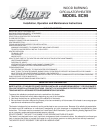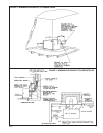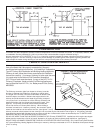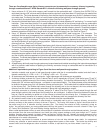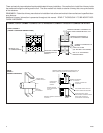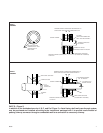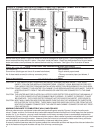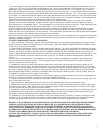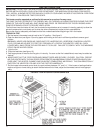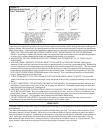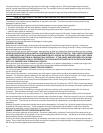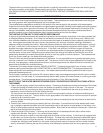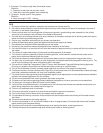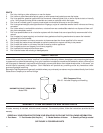EC95 5
There are five allowable ways that a chimney connector can be connected to a masonry chimney by passing
through a combustible wall. NFPA Standard 211 allows the following wall pass-through systems.
Use a minimum 3-1/2" thick brick masonry wall framed into the combustible wall. A fireclay liner (ASTM C315 or
equivalent) having a 5/8" minimum wall thickness must be used and it must be at least 12" away from any material that
could catch fire. The inside diameter of the fireclay liner shall be sized for the proper snug fit of a 6" diameter chimney
con nector pipe. The fireclay liner shall run from the outer surface of the brick wall to, but not beyond, the inner surface
of the chimney flue and shall be firmly cemented in place. See Part A of Figure 7.
Use a solid insulated listed factory-built chimney length having an inside diameter of 6" and having 1" or more of solid
insulation. There must be at least a 9" air space between the outer wall of the chimney length and any combustible
materials. The inner end of the chimney length shall be flush with the inside of the masonry chimney flue shall be
sealed to the flue and to the brick masonry penetration with nonwater-soluble refractory cement. Sheet steel supports
which are at least 24 gauge(0.024") in thickness shall be securely fastened to wall surfaces on all sides. Fasteners
between supports and the chimney length shall not penetrate the chimney liner. See Part B of Figure 7.
Use a 10" diameter ventilated thimble made of at least 24 gauge(0.024") steel having two 1" air channels. The
ventilated thimble must be separated from combustible materials by a minimum of 6" glass fiber insulation. The
opening in the combustible wall shall be covered and the thimble supported with sheet steel supports which are at
least 24 gauge (0.024") in thickness. The sheet steel supports shall be securely fastened to wall surfaces on all sides
and shall be sized to fit and hold the chimney section. Fasteners used to secure chimney sections shall not penetrate
chimney flue liner. See Part C of Figure 7.
Use an 8" inside diameter solid insulated listed factory-built chimney length which has 1" or more of solid insulation.
The minimum length of this chimney section shall be 12" and will serve as a pass-through for the 6" diameter chimney
connector. There must be at least a 12" air space between the outer wall of the chimney section and any combustible
materials. The chimney section shall be concentric with and spaced 1" away from the chimney connector by means of
sheet steel support plates on both ends of the chimney section. The opening in the combustible wall shall be covered
and the chimney section supported on both sides with sheet steel supports which are at least 24 gauge (0.024") in
thickness. The sheet steel supports shall be securely fastened to wall surfaces on all sides and shall be sized to fit and
hold the chimney section. Fasteners used to secure chimney sections shall not penetrate chimney flue liner. See Part
C of Figure 7.
A listed factory-built wall pass-through system may be purchased and installed according to the instructions packaged
with it to provide a safe method of passing the chimney connector through a combustible wall for connection to a
masonry chimney.
Additional requirements pertaining to Figure 5 and the above wall pass-through systems:
1.
2.
3.
4.
5.
Insulation material used as part of wall pass-through system shall be of noncombustible material and shall have a
thermal conductivity of 1.0 Btu • in./ft.² • °F (4.88 kg • cal/hr • m² • °C) or less
All clearances and thicknesses are minimums: larger clearances and thickness are acceptable.
A chimney thimble, as shown for 3" and 4" above (Parts C and D respectively of Figure 7) shall be for types "3" and "4"
connections to facilitate removal of the chimney connector for cleaning. The chimney thimble shall be of ASTM C315
fireclay with 5/8" minimum wall thickness , or material or equivalent durability. The inside diameter of the thimble shall
be sized for the proper snug fit of a 6" diameter chimney connector pipe. The thimble shall be installed without damage
to the chimney flue. The thimble shall extend through the chimney wall to, but not beyond, the inner surface of the
chimney flue and shall be permanently cemented in place with high temperature cement.
A chimney connector to a masonry chimney, except for 2" above (Part B of Figure 7), shall extend through the wall
pass-through system to the inner face of the chimney flue, but not beyond. It does not have to be fastened in place so
long as it cannot accidently be pulled out of the chimney or shoved into the chimney flue. If fasteners are used to
secure the chimney connector to a masonry chimney, the fasteners shall not penetrate the chimney flue liner.
Any material used to close up any opening for the connector shall be noncombustible.
1.
2.
3.
4.
5.
If the chimney connector does not have to pass through a combustible wall to get to a masonry chimney, connect the
chimney connector to the masonry chimney as shown in figure 8. The fireclay liner shown by figure 8 should be sized for
the proper snug fit of a 6” diameter chimney connector pipe. The fireclay liner should be firmly cemented in place as
shown. As previously stated, any metal prefabricated chimney this heater is connected to must be a listed Hi-Temp Type
HT Factory Built Residential Type and Building Heating Appliance Chimney.
When a metal prefabricated chimney is used, the manufacturer’s installation instructions must be followed precisely. You must
also purchase (from the same manufacturer) and install the ceiling support package or wall pass through and “T” section
package, firestops (when needed), insulation shield, roof flashing, chimney cap, etc. Maintain the proper clearance to the
structure as recommended by the manufacturer. This clearance is usually a minimum of 2 inches, although it may vary by
manufacturer or for certain components.
A listed chimney cap should be installed to prevent entrance of rain and help eliminate down drafts. An unapproved
chimney cap, protector or spark arrester can become clogged when leaves or other matter. This blocks the chimney and
causes smoke, and the dangerous carbon monoxide in smoke, to spill back into your home where it can kill you.



